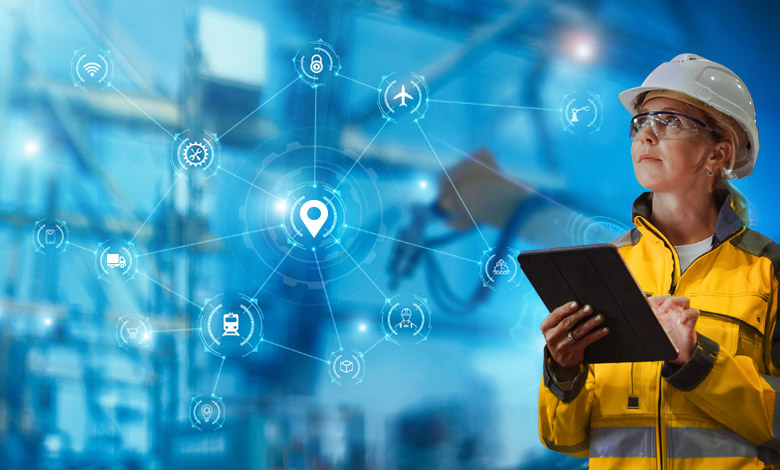Most locations solutions we think of include asset or material tracking inside of a typical facility. These are tried and true use cases to improve operations with technologies like RFID, wireless, and Bluetooth Low Energy (BLE). But what about outside of the four walls? How does a modern manufacturer track high-value products in transit or across the supply chain? How do we track forklifts, vehicles, and trucks in transit? How do we optimize operations in a yard or extended outdoor territory where operations might be equally important or benefit from data to optimize processes, reduce theft, and improve safety?
The solution is simple: Global Positioning Systems (GPS). This technology isn’t new. Heavily used in military, commercial, and civilian life, we have come to rely upon this technology to locate and navigate our world. The business use cases for GPS are no different. Low-cost GPS sensors and products now exist to make it easy to track any business asset, whether on corporate property, in the woods, or in transit to a customer.
Along with a range of proven business use cases and underlying technologies, the deployment, management, dashboards, and data integration have all significantly improved to benefit how manufacturers add smart value chains. Imagine a world where a GPS sensor can last five years on a single charge. When the sensor breaches a virtual zone, the sensor awakes to transmit its location, shares zone status and other metadata, alerts key stakeholders, and triggers integrations that further automate business processes. These features are a reality today! And utilized in use cases from theft detection, inappropriate employee behavior detection, safety, and customer experience.
Powerful, Flexible GPS Technology
The technology couldn’t be easier to acquire and deploy. At the heart is a GPS-enabled device. Many types exist with form, fit, and function-changing abilities that adapt to use cases and the object it is attached to. These devices are battery operated, utilize low-bandwidth communication technologies, and even maximize how and when they communicate to get years out of a single charge. In addition to location, many of these units can also detect other data about their environment—via embedded sensors—including impact, temperature, and humidity.
Today’s sensors can communicate in a variety of means, adjusting and providing options for manufacturers based on their specific deployment use case. Two of the most common connectivity options include cellular and LoRaWAN. The first should be obvious to most. These sensors and their services include options like 4G or 5G—and often use lightweight protocols such as IoT. Cellular is best used when assets are in transit over longer ranges, or outside of the typical business possession—like in a yard or outside a production facility. For use cases that are localized, LoRaWAN is a great option with a range of up to 15 miles. It’s simple to deploy LoRaWAN gateways that securely connect to existing network infrastructures.
Lastly, connecting and integrating data couldn’t be easier. All providers of GPS technologies today include dashboards that are easily managed and help you get everyday value, triggers, and application interfaces that drive automation options within business systems, cloud services, and third parties.
Popular Use Cases
Vehicle Tracking, Fuel Optimization, and Safety
Telematics isn’t a new topic—but for those manufacturers with a fleet of service vehicles, sales vehicles, or delivery trucks, modern telematics can be anything from tracking the location of a vehicle to fuel and route optimization, safety and accident awareness, and a whole range of outstanding features that optimize vehicle management. Best of all, these solutions are easy to deploy and bring significant return on investment in areas like efficiencies, cost reductions, customer experience, and insurance fees.
In-Transit Tracking: Not all manufacturers make products that warrant in-transit tracking, but for those with high-value products, theft across the supply chain, or who have regulatory compliance to ensure safe delivery, GPS solutions can make this all very simple. This is especially true for industries with reuseable totes or containers. While some industries use passive RFID to track key logistics points—like shipping and receiving—GPS solutions allow you to track something in real time, provide updates on location, and can send alerts on adverse conditions that might lead to a change of course, damage, or even theft.
Outdoor Asset Tracking: Some manufacturers produce large products outdoors or have a requirement to track people, forklifts, tools, and vehicles in an expansive outdoor facility. These use cases are no different from that of an indoor facility, other than the technology used to track it. GPS can provide easily deployed location sensors with little to no outdoor tracking infrastructure. They can also integrate with business systems like MES, CMMS, ERP, and CRM to streamline operations.
How Can Your Business Benefit from GPS?
There are many ways the technology can be applied to make manufacturers’ extended enterprise and supply chain smarter. GPS is a practical technology to automate wasteful activities, deliver cost-effective solutions, and improve business processes and customer experience with its easy-to-deploy platforms—constraining you only to your imagination.
If your business is looking to explore location technologies or automate various business processes aligned with corporate goals, then engage Connection’s Manufacturing Practice to learn more about this technology and the many use cases that may benefit your organization.

